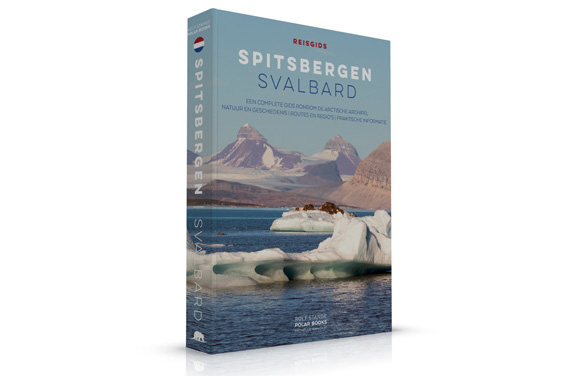-
current
recommendations- Liefdefjord
New page dedicated to one of Spitsbergen's most beautiful fjords. Background information and many photos.
- New Spitsbergen guidebook
The new edition of my Spitsbergen guidebook is out and available now!
- Liefdefjord
New page dedicated to one of Spitsbergen's most beautiful fjords. Background information and many photos.
Page Structure
-
Spitsbergen-News
- Select Month
- April 2025
- March 2025
- February 2025
- January 2025
- December 2024
- November 2024
- October 2024
- September 2024
- August 2024
- July 2024
- June 2024
- May 2024
- April 2024
- March 2024
- February 2024
- January 2024
- December 2023
- November 2023
- October 2023
- September 2023
- August 2023
- July 2023
- June 2023
- May 2023
- April 2023
- March 2023
- February 2023
- January 2023
- December 2022
- November 2022
- October 2022
- September 2022
- August 2022
- July 2022
- June 2022
- May 2022
- April 2022
- March 2022
- February 2022
- January 2022
- December 2021
- November 2021
- October 2021
- September 2021
- August 2021
- July 2021
- June 2021
- May 2021
- April 2021
- March 2021
- February 2021
- January 2021
- December 2020
- November 2020
- October 2020
- September 2020
- August 2020
- July 2020
- June 2020
- May 2020
- April 2020
- March 2020
- February 2020
- January 2020
- December 2019
- November 2019
- October 2019
- September 2019
- August 2019
- July 2019
- June 2019
- May 2019
- April 2019
- March 2019
- February 2019
- January 2019
- December 2018
- November 2018
- October 2018
- September 2018
- August 2018
- July 2018
- June 2018
- May 2018
- April 2018
- March 2018
- February 2018
- January 2018
- December 2017
- November 2017
- October 2017
- September 2017
- August 2017
- July 2017
- June 2017
- May 2017
- April 2017
- March 2017
- February 2017
- January 2017
- December 2016
- November 2016
- October 2016
- September 2016
- August 2016
- July 2016
- June 2016
- May 2016
- April 2016
- March 2016
- February 2016
- January 2016
- December 2015
- November 2015
- October 2015
- September 2015
- August 2015
- July 2015
- June 2015
- May 2015
- April 2015
- March 2015
- February 2015
- January 2015
- December 2014
- November 2014
- October 2014
- September 2014
- August 2014
- July 2014
- June 2014
- May 2014
- April 2014
- March 2014
- February 2014
- January 2014
- December 2013
- November 2013
- October 2013
- September 2013
- August 2013
- July 2013
- June 2013
- May 2013
- April 2013
- March 2013
- February 2013
- January 2013
- December 2012
- November 2012
- October 2012
- September 2012
- August 2012
- July 2012
- June 2012
- May 2012
- April 2012
- March 2012
- February 2012
- January 2012
- December 2011
- November 2011
- October 2011
- September 2011
- August 2011
- May 2011
- April 2011
- March 2011
- February 2011
- January 2011
- December 2010
- November 2010
- September 2010
- August 2010
- July 2010
- June 2010
- May 2010
- April 2010
- March 2010
- February 2010
- November 2009
- October 2009
- August 2009
- July 2009
- June 2009
- May 2009
- April 2009
- March 2009
- February 2009
- January 2009
- December 2008
- November 2008
- October 2008
- August 2008
- July 2008
- June 2008
- May 2008
- April 2008
- March 2008
- February 2008
- April 2000
- Select Month
-
weather information
-
Newsletter

| Guidebook: Spitsbergen-Svalbard |
Home → October, 2020
Monthly Archives: October 2020 − News & Stories
Guidebook “Spitsbergen-Svalbard” now available in Dutch
The guidebook “Spitsbergen-Svalbard” is now also available in Dutch!
In short words: here it is (click on the link to get to my webshop).
A more complete version of the story:
How come?
A couple of years ago in Tromsø – we were just about to set sail for Bear Island and Spitsbergen – Jonneke van Eijsden said it would be good to have the book in Dutch.
Initiative and main translator: Jonneke van Eijsden
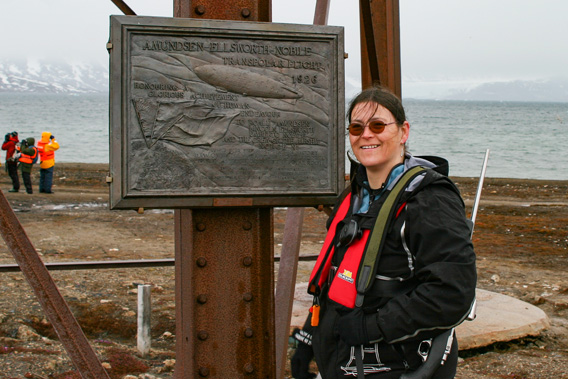
Initiative and main translator: Jonneke van Eijsden.
Sure, no doubt, I could agree on that. But the then ongoing Norwegian translation of the book had already brought me close to my limits in terms of time, money and nerves, so I was not really inclined to open up a new big project, so my slightly reserved reply was something like “fine, go ahead if you want to.”
And Jonneke went ahead and did it. The whole thing, from the table of contents to the appreciations in the end.
Quite unbelievable, isn’t it?
Much appreciated: help from friends and colleagues
But that was, of course, not all. People with solid knowledge of Dutch language and arctic terminology in various fields were needed to help the project on its way towars a book that could be printed. This group of good people included Marion den Bakker, Arjen Drost, Sarah Gerats, Regina Meijndert, Annette Scheepstra, Ronald van Belzen, Tom van Hoof and Ronald Visser. And highly knowledgeable people like Hans Beelen, Louis Beyens and Maarten Loonen, all acknowledged experts in their fields, alowed us to pick their brains.
And my old master Rinie van Meurs was so kind to contribute with a foreword!
A big “thank you” to all of you! This Dutch Spitsbergen guidebook would not exist without you!
Co-author: Michelle van Dijk
The Netherlands have got a long history in relation to Spitsbergen, starting with the discovery in 1596 during Willem Barentsz’ third voyage and the name. That led to a special perspective that is best understood and described from an inside perspective.
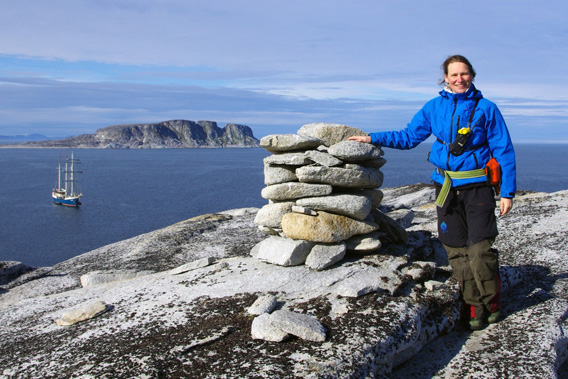
Co-author: Michelle van Dijk (on Foynøya). Photo © Birgit Lutz.
So this Dutch book has, for the first time in the by now quite long history of this book, two authors: Michelle van Dijk joined me in the role of co-author and added various sections such as one about Willem Barentsz, one about 17th century whaling, then the whole story of Barentsburg, Rijpsburg and NeSpico, Sjef van Dongen, local information about places such as Smeerenburg, … all Dutch chapters of the Dutch relationship to Spitsbergen (and, of course, not unmentioned in the other editions of the book, but Michelle wrote new versions of these sections, adding more detail and a new perspective). And of course she took off within her own field of knowledge and passion and wrote a new chapter about plants.
In other words, the new book is not just a mere translation of the pre-existing English and German versions (there is also a Norwegian one, but that was not used in the translation process), but a new book with content that the other editions don’t have, at least not as it is here. It won’t surprise that it is the thickest one of the whole family, with an impressie 656 pages.
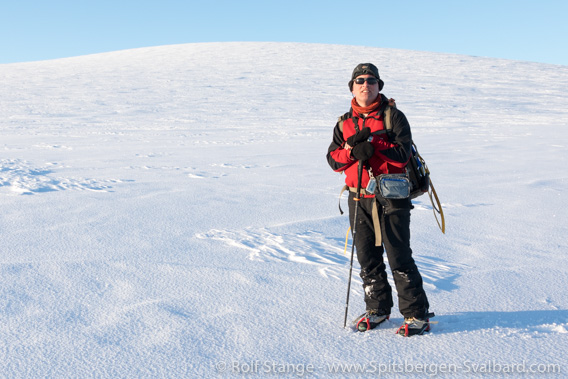
I am and remain the main author: Rolf Stange.
So, if you speak Dutch (or if you are interested anyway), click here and check it out! Orders can be placed from now and shipping will start soonest, as soon as we get the key rings in that will be shipped with the first 100 books (see below).
spitsbergengids.nl
With spitsbergengids.nl, Michelle has created a new site, dedicated to the Dutch guidebook. There you can, of course, also find Michelle’s other and own book, Sjef van Dongen – Nederlandse Poolhelt.
And an exclusive gift made in Longyearbyen with the first 100 orders
And on top of this: the first 100 orders that come in through my or Michelle’s webshop will be complemented by an exclusively made key ring made in Longyearbyen by master carpenter Wolfgang Zach, who is also the man behind the Spitsbergen driftwood picture frames and the kitchen slats. The key rings are made of two different kinds of wood, both with origins in Spitsbergen: the dark wood is from oak beams that were used in mine 7 to support the roof, and the polar bear is made from driftwood. We have got 100 of these key rings, exclusively made to come with the first 100 orders and, in this exact design, not available elsewhere!
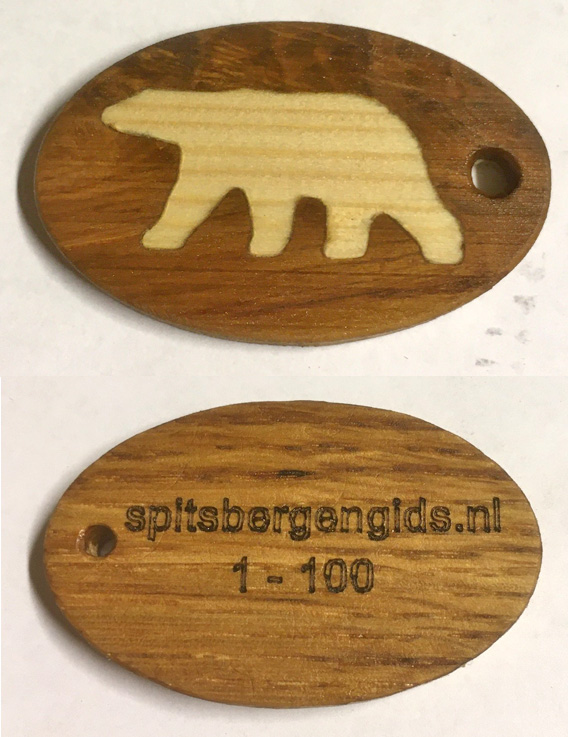
These beautiful key rings are made in Longyearbyen as an exclusive gift that comes with the first 100 copies of the Dutch Spitsbergen guidebook ordered individually through my webshop or Michelle’s 🙂
New page: Grønfjord – more than Barentsburg
A new page for the weekend! Most will know Grønfjord mainly as the place where Barentsburg is located. But it is actually a beautiful fjord with lovely scenery, interesting nature and good hiking opportunities in the summer as well as in the winter. Find background information about nature and history together with plenty of photos on the Grønfjord page which has just got a completely fresh overhaul – check it out!
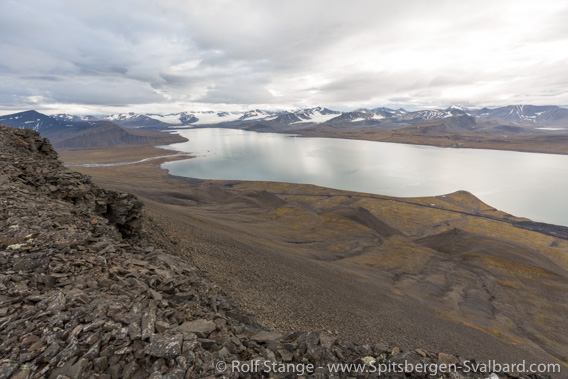
View from Grønfjordfjellet south of Barentsburg over the inner parts of Grønfjord.
One of many new photos on the overhauled Grønfjord page.
Quiet on the northern front – moving on behind the scene
Quiet on the northern front ..?
“Quiet on the northern front” is, of course, not entirely true. There is always something going on in Spitsbergen, but currently not much that would shake the world. The locals can still be happy about not having a single case of Corona/Covid 19 in Spitsbergen. Hurtigruten Svalbard considers to sell their local properties to a “serious investor” to rent their hotels etc. then on a long-term basis. I guess you have to have studied something other than geography to understand that kind of business model. The Sysselmannen will release 18 employees this year and replace them with new ones, mostly because the people have to return to their long-term engagements in mainland Norway if they want to keep them. Such as large turnover is, of course, not what anyone would want – the Sysselmannen has 45 positions in total, currently, so that is an exchange of staff of more than 30 %.
Polar bears and people have recently managed to keep a healthy distance from each other. Fortunately.
It’s things like that which are currently going on. Everything is important for some people, but it is not shaking the world.
New book projects on the way
The corona-year has, amongst others, resulted in more time at the office table than originally planned. A new book project has already more than 300 pages of text, another one is also making some progress. But many more pages will have to be written in both cases before anything will be ready for release. “New book project” is, of course, not entirely true. Both have been work in process for more than just a couple of months, to put it mildly. So there is something positive in having more time than planned.
New pages
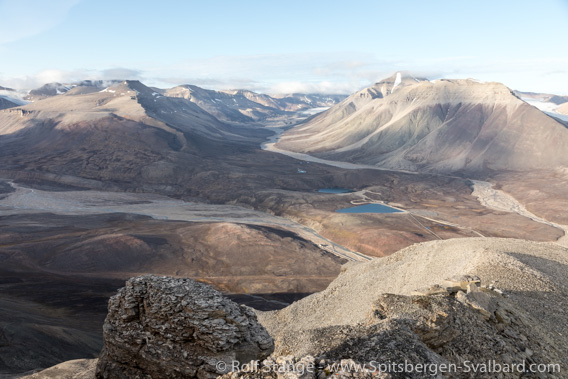
Landscape in central Dickson Land: view from Yggdrasilkampen
Illustration from the renewed page about Dickson Land and Billefjord.
Another thing that has taken up at least some speed is re-doing a number of pages within spitsbergen-svalbard.com. Many pages that I was proud of 10 years ago are getting a bit … well, old now. A number of pages have got new maps, illustrations, photo galleries and revised text as necessary. This includes pages about beautiful fjords that many of you will know, and pages about more unknown places that you can explore if you feel like travelling Spitsbergen online – the door is open, just come in, there is plenty of good stuff waiting!
- The renewed page about Dickson Land and Billefjord. One of the most beautiful and interesting parts of Spitsbergen, believe it or not! An area that certainly deserved something better than what I had in that place until a few days ago.
- The same can be said about the page about the area in outer Isfjord between Kapp Linné and Festningen.
- Kongsfjord Krossfjord used to be merged into one page until recently, an unbearable situation 🙂 now both of these beautiful and frequently visited fjords have got their own, improved page.
- There are, of course, also a couple of new panorama pages, dedicated to individual sites rather than larger areas (in contrast to the pages mentioned above), some of them with many images (both panorama and conventional photos) and a lot of background information, such as the page about Svenskehuset.
- The same is the case with the new page about Brucebyen, a lovely and very interesting place in Billefjord. I have a lot of fond memories from Brucebyen, but the new page is, of course, not about my own stories. It is rather about the history of the famous Scottish polar explorer William S. Bruce and his Scottish Spitsbergen Syndicate.
- What else do we have? Oh, of course, Collinsodden at the entrance of Krossfjord. That’s a place I bett most of you won’t have been to, but it is worth a visit, the scenery is not exactly what you would initially think of when you mentally picture Spitsbergen, but it is beautiful and there is, of course, an interesting little story connected to the place.
- And Wigdehlpynten in Woodfjord. Colours, colours … that is Christiane Ritter’s red desert sand.
… to be continued.
So there is plenty of reading material for one or two rainy autumn days or dark winter evenings. By the way, as you may have noticed, it comes not only completely free, but also without all the online ads popping up that you have on most other “free” websites, which gather a lot of your data and reduce the reading experience greatly in my opinion. That’s how other website owners make their money. Nothing like that on spitsbergen-svalbard.com. Not that economy didn’t play a role for me, obviously, and this years I would have more reason than at other times to tap that resource. But I don’t want to do that, because I like my website as it is and I want to keep it this way. If you want to support it – have a look at my webshop, there is a lot of good arctic books and fine other things that might give you (or someone you like) pleasure.
So … have a look at these new/renewed pages listed above. I greatly enjoyed making them and I hope they find your interest.
Spitsbergen-Svalbard: the guidebook – now coming up in Dutch
The guidebook Spitsbergen-Svalbard has been translated and it is now printed, soon it will be ready for shipping 🙂 another big project that has come to an end – well, not really, but the process of making the book in the first place. More about that soon.
National budget 2021: hundreds of millions for Spitsbergen
The Norwegian government has published the suggestions for the new national budget for 2021. The plans include several hundred million Norwegian kroner for Spitsbergen:
- The labour inspectore (Arbeitstilsynet) will be strengthened with one million kroner.
- The mining company Store Norske is to receive 40 millions to compensate for expected losses in mine 7, which is suffering from generally high costs and additional problems due to flooding with glacial meltwater after the hot summer days in July. The government aims at securing the supply of Longyearbyen’s coal power plant with local coal.
- 61.1 Millionen are needed for securing Longyearbyen against snow avalanches and river floods – both are very important issues for Longyearbyen.
- The comprehensive clean-up of Sveagruva and the nearby mines of Lunckefjellet and Svea Nord is expected to require 412.8 millions in 2021.
- Svalbardmuseum is in for a grant of 1.5 millions, to “strengthen the museum and stimulate more activity”, also in the light (or, rather, darkness) of the corona crisis.
- Also the Sysselmannen will get increased fundings, amongst others for to create a stilling for a lawyer to work tasks that a public prosecutor might otherwise take care of, when cases leave the Sysselmannen – an institution that includes the police – in Longyearbyen.
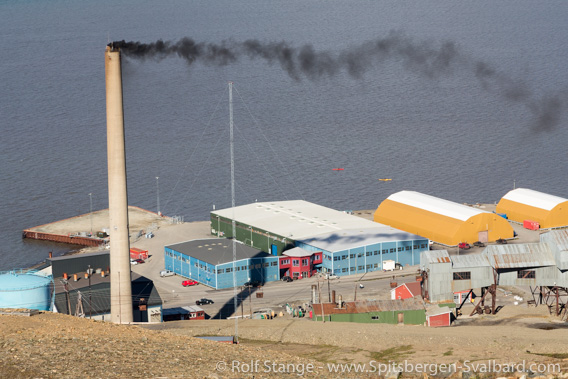
Longyearbyen has a lot of important issues to deal with and some of them will be taken important steps further with Oslo’s new budget for 2021. Getting a new power source on the way to replace the old coal power plant would certainly make sense, to mention just one of many problems that Longyearbyen needs to take care of.
The local tourism organisation Visit Svalbard was disappointed by getting an increase of only 100,000 kroner on top of the current budget of 3.05 millions. Visit Svalbard represents many local companies, all of which are hit hard by the corona crisis.
But community representatives expressed themselves mostly satisfied. Amongst others, Longyearbyen will now also get the opportunity to apply for fundings from “klimasats”, a public fund for for climate protection projects that was established for mainland communities already in 2016. Longyearbyen has very high per capita CO2 emissions and electricity is very expensive. A new solution might bring considerable improvement for both issues. Currently, a hydrogen-based solution is discussed. Hydrogen could be supplied from north Norway and is expected to reduce both CO2 emissions and the high prices for electricity significantly.
The government’s budget plans still need the parliament’s approval.
Isfjord is a high-arctic fjord again. For a while.
Less and thinner ice in the innermost branches of Isfjord such as Tempelfjord and Billefjord, and a solid ice-cover in the wide, central parts of Isfjord proper nothing but a remote dream – that has been the reality in Spitsbergen’s largest fjord in recent years, which does hardly live up to its name, “Ice fjord”, anymore. Considering oceanographical and biologial characteristics, Isfjord has not really been a high-arctic fjord anymore, but rather a sub-arctic one.
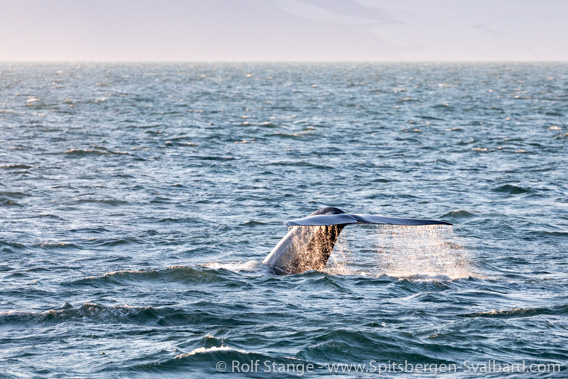
Isfjord has developed a sub-arctic oceanographical character in recent years,
something that has involved, for example, more whale sightings.
The photo shows a blue whale in Isfjord in September 2018.
This may currently be changing again – not permanently, however, but at least for a while. This is the result of oceanographical data that have recently been gathered by a team of UNIS scientists. The data are part of a long-term project to monitor the development in Isfjord. Frank Nielsen, professor for oceanography at UNIS, and his team have now published a report in Svalbardposten.
A key result is that there is currently much less mild, salt-rich Atlantic water in Isfjord than in previous years and the remaining volume of this water is largely at depths below 150 metres. In recent years, mild Atlantic water that drifts north with the Gulf Stream and reaches Spitsbergen’s west coast, where it is called the West Spitsbergen current, has had an increasingly strong influence in the fjords on the west coast. These have, as a consequence, lost much of their high-arctic character in terms of oceanography and biodiversity, rather becoming sub-arctic fjords instead. Important indicators include water temperatures, salt concentrations and species composition, especially of zooplankton.
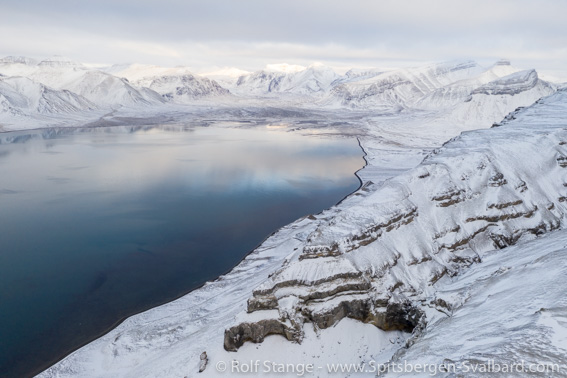
In the innermost branches, such as Petuniabukta (pictured here),
Isfjord’s high-arctic character has been retained so far.
Recent climatic changes have led to this development: part of the complex pictures are changed routes of low pressures, which now move north between Greenland and Spitsbergen, rather than moving east over the Barents Sea. The new route of the low pressures tends to push Atlantic water north and into Spitsbergen’s west coast fjords – an effect that can last over years, even though the low pressures disappear after a few days.
This year, however, regional weather patterns have been more like what they used to be in the past, with a more stable northerly influence which has, noticeably, led to few warm air incursions with melting temperatures in the winter, something that had become more common in the years before. Another result of the current air flow pattern in this sector of the Arctic is the less pronounced influence of temperate water masses in Spitsbergen’s fjords on the west coast. Other reasons for this current development may include the strong melting of local glaciers in the very warm weather of the last summer, which has led to a higher input of cold freshwater to the top layer of the fjord.
All this has now led to a change of species-composition of zooplankton back to a more high-arctic mixture. Arctic zooplankton is largely dominated by copepods. In recent years, the sub-arctic species Calanus finmarchicus has become dominant in most parts of Isfjord, but now it is mainly the high-arctic species Calanus glacialis that is dominant again.
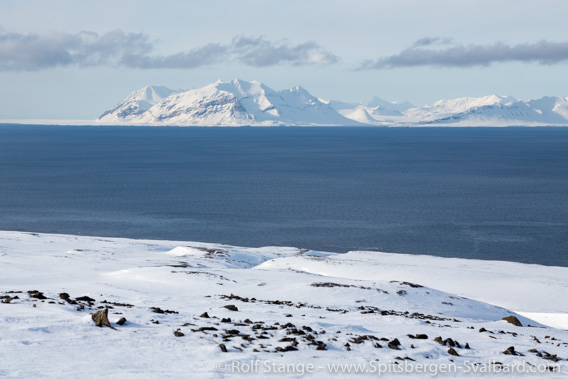
Currently, also central parts of Isfjord have a high-arctic oceanographical character again.
If this development is not soon terminated by strong low pressures associated with heavy storms from the “wrong” direction, then one of the results could be an ice cover that is more extensive and stronger than seen in recent years. Another result, if it lasts for a while, may be fewer whales and less cod in Isfjord next year.
But in case anyone is struck by the thought that climate change in the Arctic is called off now: this is not the case. As Nilsen puts it in his article, it is not a stable situation, but “rather a local dead-cat bounce within a warming Arctic” (original quote: Men en stabil situasjon er det ikke, det er mer som en lokal krampetrekning i et Arktis under oppvarming).
Record-low in sea ice cover in September
September is generaly the months with the lowest sea ice cover in the Arctic: the summer warmth has melted a lot of ice, and the cold of the winter is yet to come. So is is normal to expect little drift ice near Spitsbergen in September.
BUT – what does “little” drift ice mean? Even just a quick glance at the long-term development reveals a clear trend towards less and less ice. Arctic sea ice is monitored since 1979, and never has there been as little ice as in September, following a summer that has brought Longyearbyen record-breaking temperatures and a hot summer also elsewhere in the Arctic, such as Siberia, to mention just one example.
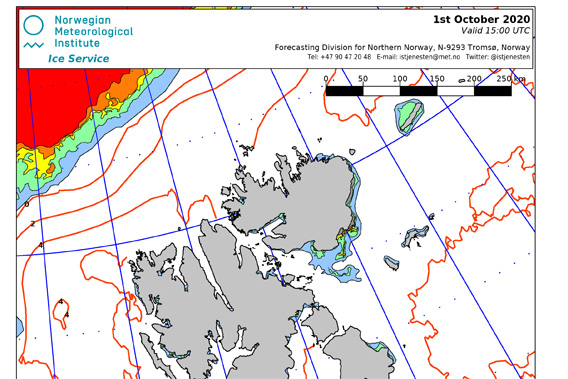
Ice chart of northern Svalbard as of 01 October: the “cold coast” (Svalbard) is currently completely free of ice.
© Norwegian Meteorological Institute.
According to a press release by the Norwegian Meteorological Institute, the monthly temperature average for September for the whole Arctic was 2.9 degrees above the long-term average, which is based on the reference period 1961-1990. When a new reference period will be introduced in 2021, based on the three decades from 1991 to 2020, the temperature deviations will appear less dramatic. But this will be no reason to declare the current climate change history, it will just be a different perception due to a new statistical reference period. An artefact, in other words.
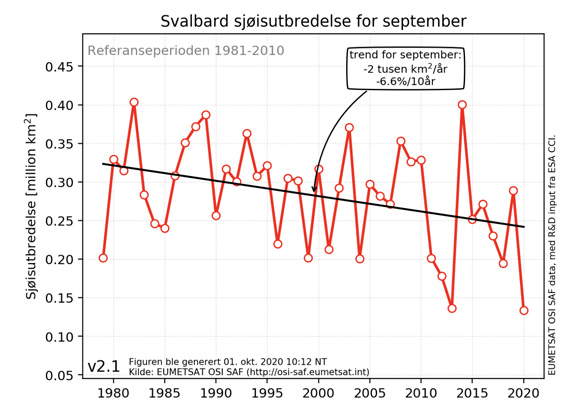
Changes of the sea ice cover in Spitsbergen from 1979 to 2020.
September 2020 has yielded a new all-time low.
© Norwegian Meteorological Institute.
Signe Aaboe, scientist at the Norwegian Meteorological Institute, does not doubt that the recent record values of arctic temperature and ice are due to man-made climate change.
News-Listing live generated at 2025/April/30 at 19:45:41 Uhr (GMT+1)
